日常英语口语课堂教学资料
- 格式:doc
- 大小:186.00 KB
- 文档页数:17
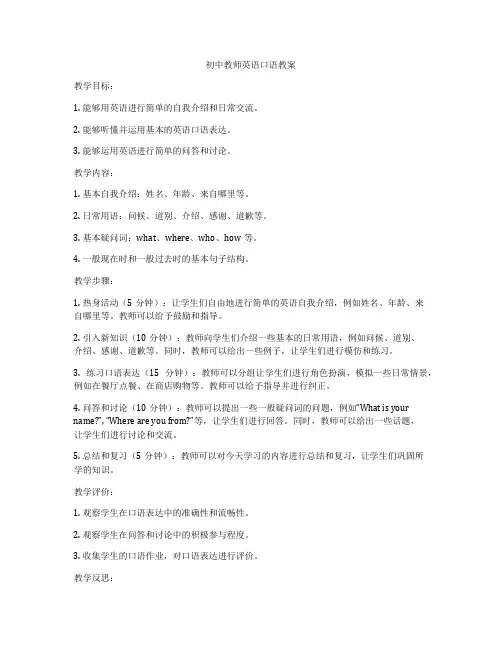
初中教师英语口语教案教学目标:1. 能够用英语进行简单的自我介绍和日常交流。
2. 能够听懂并运用基本的英语口语表达。
3. 能够运用英语进行简单的问答和讨论。
教学内容:1. 基本自我介绍:姓名、年龄、来自哪里等。
2. 日常用语:问候、道别、介绍、感谢、道歉等。
3. 基本疑问词:what、where、who、how等。
4. 一般现在时和一般过去时的基本句子结构。
教学步骤:1. 热身活动(5分钟):让学生们自由地进行简单的英语自我介绍,例如姓名、年龄、来自哪里等。
教师可以给予鼓励和指导。
2. 引入新知识(10分钟):教师向学生们介绍一些基本的日常用语,例如问候、道别、介绍、感谢、道歉等。
同时,教师可以给出一些例子,让学生们进行模仿和练习。
3. 练习口语表达(15分钟):教师可以分组让学生们进行角色扮演,模拟一些日常情景,例如在餐厅点餐、在商店购物等。
教师可以给予指导并进行纠正。
4. 问答和讨论(10分钟):教师可以提出一些一般疑问词的问题,例如“What is your name?”, “Where are you from?”等,让学生们进行回答。
同时,教师可以给出一些话题,让学生们进行讨论和交流。
5. 总结和复习(5分钟):教师可以对今天学习的内容进行总结和复习,让学生们巩固所学的知识。
教学评价:1. 观察学生在口语表达中的准确性和流畅性。
2. 观察学生在问答和讨论中的积极参与程度。
3. 收集学生的口语作业,对口语表达进行评价。
教学反思:在教学过程中,教师要注意给予学生足够的鼓励和指导,帮助他们建立自信心。
同时,教师也要注重纠正学生的发音和语法错误,让他们能够正确地运用英语进行口语表达。
此外,教师可以适当增加一些有趣的口语活动,提高学生的学习兴趣和积极性。
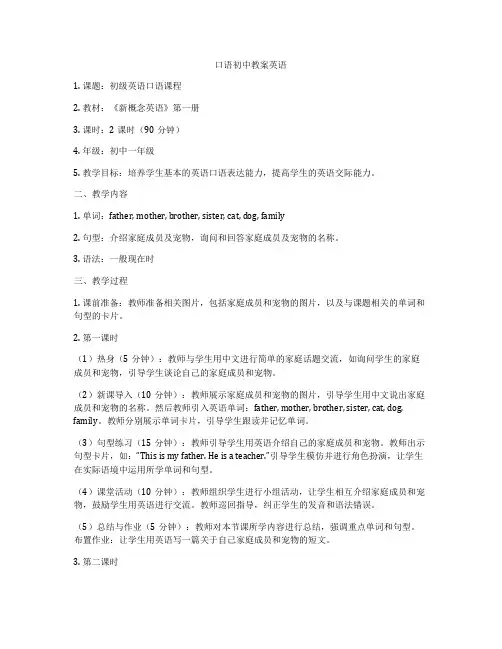
口语初中教案英语1. 课题:初级英语口语课程2. 教材:《新概念英语》第一册3. 课时:2课时(90分钟)4. 年级:初中一年级5. 教学目标:培养学生基本的英语口语表达能力,提高学生的英语交际能力。
二、教学内容1. 单词:father, mother, brother, sister, cat, dog, family2. 句型:介绍家庭成员及宠物,询问和回答家庭成员及宠物的名称。
3. 语法:一般现在时三、教学过程1. 课前准备:教师准备相关图片,包括家庭成员和宠物的图片,以及与课题相关的单词和句型的卡片。
2. 第一课时(1)热身(5分钟):教师与学生用中文进行简单的家庭话题交流,如询问学生的家庭成员和宠物,引导学生谈论自己的家庭成员和宠物。
(2)新课导入(10分钟):教师展示家庭成员和宠物的图片,引导学生用中文说出家庭成员和宠物的名称。
然后教师引入英语单词:father, mother, brother, sister, cat, dog, family。
教师分别展示单词卡片,引导学生跟读并记忆单词。
(3)句型练习(15分钟):教师引导学生用英语介绍自己的家庭成员和宠物。
教师出示句型卡片,如:“This is my father. He is a teacher.”引导学生模仿并进行角色扮演,让学生在实际语境中运用所学单词和句型。
(4)课堂活动(10分钟):教师组织学生进行小组活动,让学生相互介绍家庭成员和宠物,鼓励学生用英语进行交流。
教师巡回指导,纠正学生的发音和语法错误。
(5)总结与作业(5分钟):教师对本节课所学内容进行总结,强调重点单词和句型。
布置作业:让学生用英语写一篇关于自己家庭成员和宠物的短文。
3. 第二课时(1)复习(5分钟):教师通过提问方式复习上节课所学单词和句型,检查学生作业完成情况。
(2)口语练习(15分钟):教师出示情景卡片,让学生根据卡片内容进行角色扮演,运用所学单词和句型进行口语交流。

矿产资源开发利用方案编写内容要求及审查大纲
矿产资源开发利用方案编写内容要求及《矿产资源开发利用方案》审查大纲一、概述
㈠矿区位置、隶属关系和企业性质。
如为改扩建矿山, 应说明矿山现状、
特点及存在的主要问题。
㈡编制依据
(1简述项目前期工作进展情况及与有关方面对项目的意向性协议情况。
(2 列出开发利用方案编制所依据的主要基础性资料的名称。
如经储量管理部门认定的矿区地质勘探报告、选矿试验报告、加工利用试验报告、工程地质初评资料、矿区水文资料和供水资料等。
对改、扩建矿山应有生产实际资料, 如矿山总平面现状图、矿床开拓系统图、采场现状图和主要采选设备清单等。
二、矿产品需求现状和预测
㈠该矿产在国内需求情况和市场供应情况
1、矿产品现状及加工利用趋向。
2、国内近、远期的需求量及主要销向预测。
㈡产品价格分析
1、国内矿产品价格现状。
2、矿产品价格稳定性及变化趋势。
三、矿产资源概况
㈠矿区总体概况
1、矿区总体规划情况。
2、矿区矿产资源概况。
3、该设计与矿区总体开发的关系。
㈡该设计项目的资源概况
1、矿床地质及构造特征。
2、矿床开采技术条件及水文地质条件。

初中英语日常生活口语练习教案本教案旨在帮助初中学生提高英语口语能力,特别是在日常生活中运用英语进行交流的能力。
以下是一些示例练习和教学方法,供教师参考和运用。
【教案】主题:日常生活口语练习目标:提高学生在日常生活中运用英语的能力,包括问候、购物、约会、饮食等方面的口语表达。
教学步骤:一、问候与自我介绍教师可以通过模拟对话等形式,教授学生常用的问候语和自我介绍的表达方式。
例如:1. 问候语:- Hello! / Hi!- How are you? (回答:I'm fine, thank you! 或者:I'm not so good.)- What's up?2. 自我介绍:- My name is ______.- I am ____ years old.- I am from ______.二、购物英语教师可以引导学生在日常生活中进行购物对话的练习。
例如:学生A:Excuse me, how much is this T-shirt?学生B(扮演店员的角色):It's 20 dollars.学生A:Can I try it on?学生B:Sure, the fitting rooms are over there.学生A:Thank you. I'll take it.三、约会英语教师可以组织学生进行关于约会的对话练习。
例如:学生A:Would you like to go to the movies with me tonight?学生B:Sure, what time?学生A:How about 7 o'clock?学生B:Sounds good. Where should we meet?学生A:Let's meet in front of the theater.学生B:Okay, see you then!四、饮食英语教师可以引导学生进行关于饮食的对话练习。
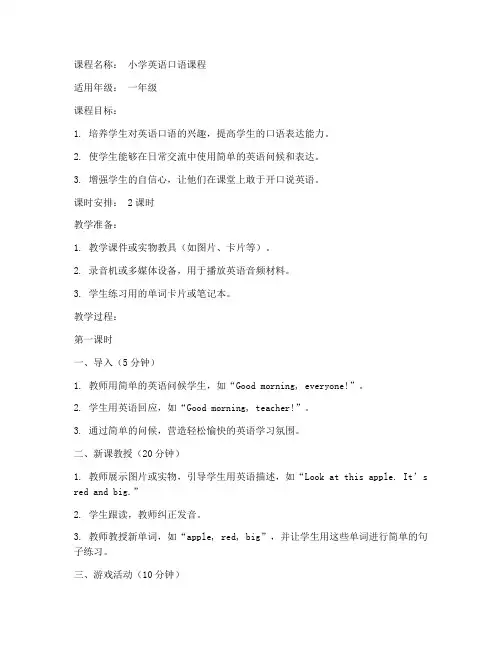
课程名称:小学英语口语课程适用年级:一年级课程目标:1. 培养学生对英语口语的兴趣,提高学生的口语表达能力。
2. 使学生能够在日常交流中使用简单的英语问候和表达。
3. 增强学生的自信心,让他们在课堂上敢于开口说英语。
课时安排: 2课时教学准备:1. 教学课件或实物教具(如图片、卡片等)。
2. 录音机或多媒体设备,用于播放英语音频材料。
3. 学生练习用的单词卡片或笔记本。
教学过程:第一课时一、导入(5分钟)1. 教师用简单的英语问候学生,如“Good morning, everyone!”。
2. 学生用英语回应,如“Good morning, teacher!”。
3. 通过简单的问候,营造轻松愉快的英语学习氛围。
二、新课教授(20分钟)1. 教师展示图片或实物,引导学生用英语描述,如“Look at this apple. It’s red and big.”2. 学生跟读,教师纠正发音。
3. 教师教授新单词,如“apple, red, big”,并让学生用这些单词进行简单的句子练习。
三、游戏活动(10分钟)1. 组织“我说你做”游戏,教师用英语描述动作,如“Jump!”,学生根据指令做相应的动作。
2. 通过游戏,让学生在轻松愉快的氛围中练习英语口语。
四、小组活动(10分钟)1. 将学生分成小组,每组选一个组长。
2. 教师给出一个主题,如“我的家庭”,让学生用英语进行小组讨论。
3. 每组派代表进行汇报,教师给予评价和鼓励。
五、总结与作业(5分钟)1. 教师总结本节课所学内容,强调重点单词和句型。
2. 布置作业:让学生回家后用所学单词和句型描述自己的家庭。
第二课时一、复习(5分钟)1. 教师用英语提问,如“Can you tell me about your family?”2. 学生用英语回答,教师纠正发音。
二、拓展练习(15分钟)1. 教师播放英语歌曲或小故事,让学生跟读。
2. 学生模仿歌曲或故事中的角色进行角色扮演。
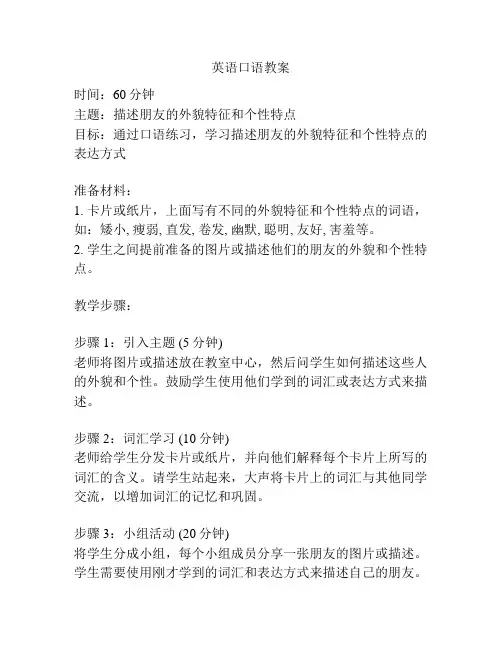
英语口语教案时间:60分钟主题:描述朋友的外貌特征和个性特点目标:通过口语练习,学习描述朋友的外貌特征和个性特点的表达方式准备材料:1. 卡片或纸片,上面写有不同的外貌特征和个性特点的词语,如:矮小, 瘦弱, 直发, 卷发, 幽默, 聪明, 友好, 害羞等。
2. 学生之间提前准备的图片或描述他们的朋友的外貌和个性特点。
教学步骤:步骤1:引入主题 (5分钟)老师将图片或描述放在教室中心,然后问学生如何描述这些人的外貌和个性。
鼓励学生使用他们学到的词汇或表达方式来描述。
步骤2:词汇学习 (10分钟)老师给学生分发卡片或纸片,并向他们解释每个卡片上所写的词汇的含义。
请学生站起来,大声将卡片上的词汇与其他同学交流,以增加词汇的记忆和巩固。
步骤3:小组活动 (20分钟)将学生分成小组,每个小组成员分享一张朋友的图片或描述。
学生需要使用刚才学到的词汇和表达方式来描述自己的朋友。
其他小组成员需要从描述中猜出图片或描述所属的朋友。
鼓励学生使用不同的句子结构和词汇来增加描述的准确性。
步骤4:整体讨论 (15分钟)全班讨论学生描述朋友时使用的词汇和表达方式。
老师可以提供一些建议,并给学生一些常用的形容词和短语来描述外貌和个性特点。
学生可以互相分享他们认为最准确和有趣的描述方式。
扩展活动:1. 学生之间可以交换小组,并分享更多朋友的描述,以增加他们的口语练习机会。
2. 老师可以播放一些关于描述朋友外貌和个性的视频,让学生更好地理解相关的表达方式。
3. 学生可以写一篇关于他们朋友外貌和个性的短文,并可以通过朗读或演讲的方式进行展示。
评估方式:观察学生在小组活动和整体讨论中的参与程度和口语表达的准确性。
鼓励学生互相帮助和提供正确的反馈。
可根据学生的参与和表现,给予积极的反馈和建议。
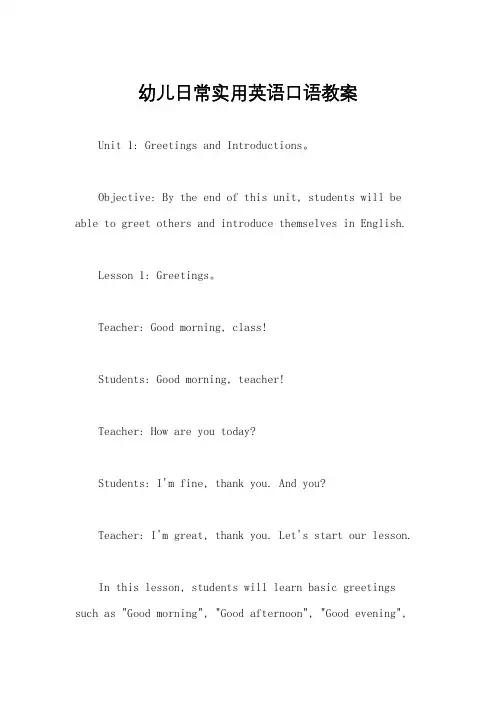
幼儿日常实用英语口语教案Unit 1: Greetings and Introductions。
Objective: By the end of this unit, students will be able to greet others and introduce themselves in English.Lesson 1: Greetings。
Teacher: Good morning, class!Students: Good morning, teacher!Teacher: How are you today?Students: I'm fine, thank you. And you?Teacher: I'm great, thank you. Let's start our lesson.In this lesson, students will learn basic greetings such as "Good morning", "Good afternoon", "Good evening",and "Hello". They will also learn how to respond to these greetings with "I'm fine, thank you" or "I'm great, thank you".Lesson 2: Introductions。
Teacher: Now, let's practice introducing ourselves. My name is Miss Smith. What's your name?Student 1: My name is Tom.Student 2: My name is Emily.Teacher: Nice to meet you, Tom and Emily.In this lesson, students will learn how to introduce themselves by saying "My name is..." and how to respond to introductions with "Nice to meet you".Unit 2: Daily Activities。
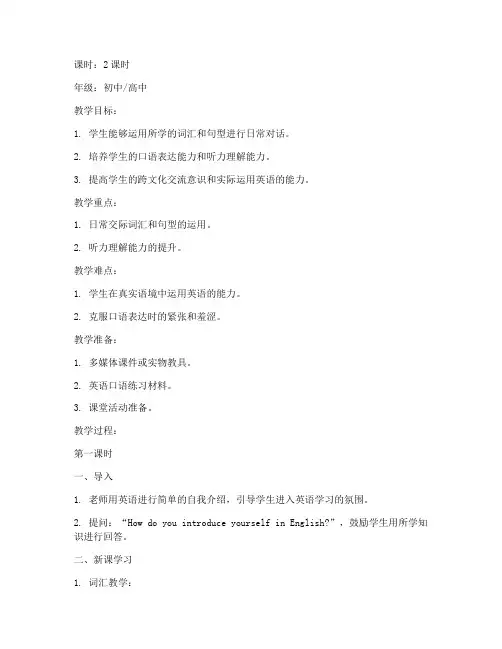
课时:2课时年级:初中/高中教学目标:1. 学生能够运用所学的词汇和句型进行日常对话。
2. 培养学生的口语表达能力和听力理解能力。
3. 提高学生的跨文化交流意识和实际运用英语的能力。
教学重点:1. 日常交际词汇和句型的运用。
2. 听力理解能力的提升。
教学难点:1. 学生在真实语境中运用英语的能力。
2. 克服口语表达时的紧张和羞涩。
教学准备:1. 多媒体课件或实物教具。
2. 英语口语练习材料。
3. 课堂活动准备。
教学过程:第一课时一、导入1. 老师用英语进行简单的自我介绍,引导学生进入英语学习的氛围。
2. 提问:“How do you introduce yourself in English?”,鼓励学生用所学知识进行回答。
二、新课学习1. 词汇教学:- 展示常用日常交际词汇,如:hello, good morning, thank you, please, sorry, goodbye 等。
- 学生跟读并模仿发音。
- 进行词汇卡片游戏,巩固记忆。
2. 句型教学:- 展示常用日常交际句型,如:What's your name? How are you? I'm fine, thank you. 等。
- 学生跟读并模仿发音。
- 进行句型接龙游戏,巩固记忆。
三、课堂活动1. 分组讨论:让学生分成小组,用所学词汇和句型进行简单的对话练习。
2. 角色扮演:老师准备几个场景,让学生分组进行角色扮演,如:在餐厅点餐、在超市购物等。
四、总结1. 老师对学生的课堂表现进行点评,总结本节课所学内容。
2. 布置课后作业,如:用所学词汇和句型写一篇简单的英语日记。
第二课时一、复习1. 老师提问,检查学生对上一节课所学词汇和句型的掌握情况。
2. 学生进行小组练习,巩固所学知识。
二、听力训练1. 老师播放一段英语听力材料,让学生认真听并回答问题。
2. 学生分组讨论,分享听力过程中的感受和收获。
三、口语练习1. 老师提供几个话题,让学生进行小组讨论,并用所学词汇和句型进行表达。
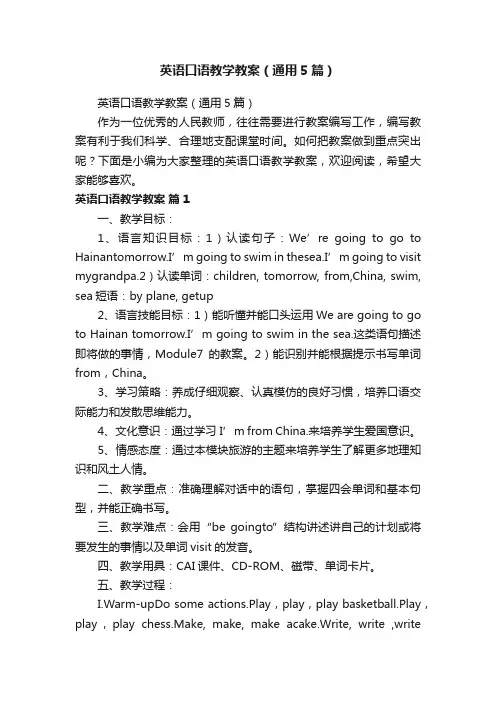
英语口语教学教案(通用5篇)英语口语教学教案(通用5篇)作为一位优秀的人民教师,往往需要进行教案编写工作,编写教案有利于我们科学、合理地支配课堂时间。
如何把教案做到重点突出呢?下面是小编为大家整理的英语口语教学教案,欢迎阅读,希望大家能够喜欢。
英语口语教学教案篇1一、教学目标:1、语言知识目标:1)认读句子:We’re going to go to Hainantomorrow.I’m going to swim in thesea.I’m going to visit mygrandpa.2)认读单词:children, tomorrow, from,China, swim, sea短语:by plane, getup2、语言技能目标:1)能听懂并能口头运用We are going to go to Hainan tomorrow.I’m going to swim in the sea.这类语句描述即将做的事情,Module7的教案。
2)能识别并能根据提示书写单词from,China。
3、学习策略:养成仔细观察、认真模仿的良好习惯,培养口语交际能力和发散思维能力。
4、文化意识:通过学习I’m from China.来培养学生爱国意识。
5、情感态度:通过本模块旅游的主题来培养学生了解更多地理知识和风土人情。
二、教学重点:准确理解对话中的语句,掌握四会单词和基本句型,并能正确书写。
三、教学难点:会用“be goingto”结构讲述讲自己的计划或将要发生的事情以及单词visit的发音。
四、教学用具:CAI课件、CD-ROM、磁带、单词卡片。
五、教学过程:I.Warm-upDo some actions.Play,play,play basketball.Play,play,play chess.Make, make, make acake.Write, write ,writealetter.Play, play, playbasketball.Swim, swim, swim in thesea.(学习词组并让学生做动作)II.PresentationT:I like swimming.Do youlike swimming?S:Yse.T:But nowit’s very cold, so I’m going to go a warmer place(课件展示海南的图片以及句子I’m going to go to Hainan.领读跟读)I like sports and I liketravelling too. Look, I’m going to go to…继续出示课件北京、上海等地的图片和I’m going to go to……引导学生说出I’m going to go toBeijing/Shanghai……III.Practice一.课件出示中国地图让学生用I’m going to go to…这个句型来描述自己将要去的地方。
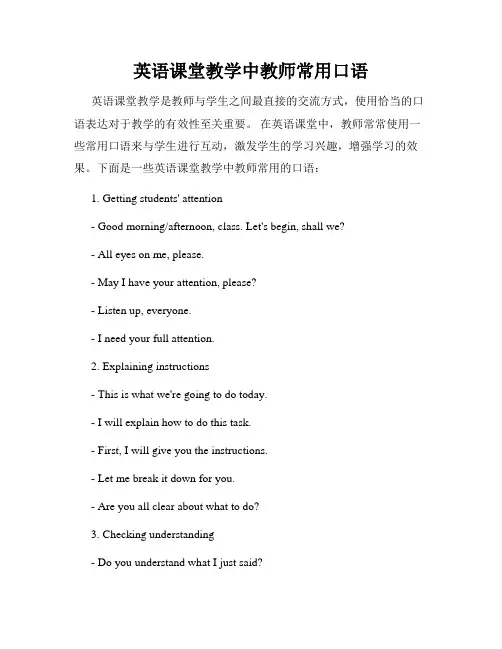
英语课堂教学中教师常用口语英语课堂教学是教师与学生之间最直接的交流方式,使用恰当的口语表达对于教学的有效性至关重要。
在英语课堂中,教师常常使用一些常用口语来与学生进行互动,激发学生的学习兴趣,增强学习的效果。
下面是一些英语课堂教学中教师常用的口语:1. Getting students' attention- Good morning/afternoon, class. Let's begin, shall we?- All eyes on me, please.- May I have your attention, please?- Listen up, everyone.- I need your full attention.2. Explaining instructions- This is what we're going to do today.- I will explain how to do this task.- First, I will give you the instructions.- Let me break it down for you.- Are you all clear about what to do?3. Checking understanding- Do you understand what I just said?- Shall I repeat that?- Are you following me so far?- Does everyone get it?- Any questions before we move on?4. Encouraging participation- I'd like to hear from each of you.- Don't be shy, feel free to share your ideas. - Who would like to volunteer?- Speak up, don't hesitate.- Everyone's opinion matters in this class.5. Giving feedback- Good job!- Well done!- You're on the right track.- I like how you explained your answer.- Keep up the good work.6. Asking for opinions- What do you think about this topic?- How do you feel about this issue?- Can you share your thoughts on...?- Do you agree or disagree? Why?- What is your perspective on this matter?7. Explaining difficult concepts- Let me clarify this for you.- Allow me to elaborate.- What I mean by that is...- To put it simply,...- Here's an example to help you understand better.8. Encouraging collaboration- Work together in pairs/groups.- Discuss with your partner/team.- Share your findings with the class.- Let's have a class discussion.- Help each other out.9. Time management- We have 10 minutes left.- Let's move on to the next activity.- Wrap it up, please.- Can we finish this task within the given time?- Make sure you manage your time wisely.10. Wrapping up the lesson- We've covered a lot today.- To summarize...- In conclusion...- Any final questions before we end?- Remember to review what we've learned.以上就是英语课堂教学中教师常用的口语表达。
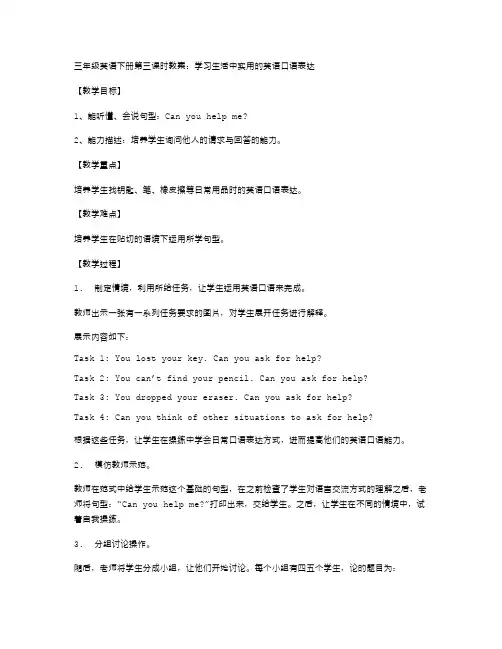
三年级英语下册第三课时教案:学习生活中实用的英语口语表达【教学目标】1、能听懂、会说句型:Can you help me?2、能力描述:培养学生询问他人的请求与回答的能力。
【教学重点】培养学生找钥匙、笔、橡皮擦等日常用品时的英语口语表达。
【教学难点】培养学生在贴切的语境下运用所学句型。
【教学过程】1.制定情境,利用所给任务,让学生运用英语口语来完成。
教师出示一张有一系列任务要求的图片,对学生展开任务进行解释。
展示内容如下:Task 1: You lost your key. Can you ask for help?Task 2: You can’t find your pencil. Can you ask for help?Task 3: You dropped your eraser. Can you ask for help?Task 4: Can you think of other situations to ask for help?根据这些任务,让学生在操练中学会日常口语表达方式,进而提高他们的英语口语能力。
2.模仿教师示范。
教师在范式中给学生示范这个基础的句型,在之前检查了学生对语言交流方式的理解之后,老师将句型:“Can you help me?”打印出来,交给学生。
之后,让学生在不同的情境中,试着自我操练。
3.分组讨论操作。
随后,老师将学生分成小组,让他们开始讨论。
每个小组有四五个学生,论的题目为:“当你遇到问题时,如何请求帮助。
”让同学们就这个问题进行讨论,每个小组讨论完毕后,让一个学生向全班汇报讨论结果,然后由全班参与评价。
4.老师点拨,纠正。
在学生进行讨论的过程中,教师需要时刻留意学生的口语表达,随时指正他们的错误和不足之处。
对于口语表达不成功的学生,教师应该采取干预和纠正的措施。
5.角色扮演。
由于这个句型围绕“请求”展开,所以接下来应该为学生展现具有实际含义的情境。
小学英语口语教学教案(6篇)以下是网友分享的关于小学英语口语教学教案的资料6篇,希望对您有所帮助,就爱阅读感谢您的支持。
篇一:小学英语口语教学教案(一) 英语听说唱综述:在新课标的要求下,小学英语应该以培养学生的兴趣与实际运用能力为主。
根据小孩子活泼好动,模仿性强的心理特点,这门课程主要围绕学唱英文歌(Singing songs)和模仿对话(Let’s talk)两部分,让学生们感受到英语的魅力。
歌曲能激发他们的兴趣,提高学习效益,课前课后唱一首英文歌,集中学生注意力的同时,寓学于唱。
同时,模仿对话的环节,增加学生的实践量,训练语音语调,提高学生的听说能力,创设轻松愉快的学习环境和学习氛围。
课程安排:第一节课:1-10分钟,教师和学生互相自我介绍,教师介绍英语听说唱的开课目的、该课的特点、大概的课程安排以及应该怎样学好。
11-20分钟,教师教会学生一首简单的英文歌Little Bird。
21-25分钟,教师介绍这首英文歌曲的意思,让学生们懂得学习英语有很多途径和方式并且学习小小鸟努力勇敢飞的精神。
25-30分钟,教师让学生们看一小段小学英语教材的视频,温故知新,并从中巩固一些句型,如“This is our school”和”Where is the playground?”等。
31-38分钟,学生模仿视频进行简单对话,锻炼学生开口说英语能力。
39-40分钟,结束前唱一首Little Bird,让学生们保持注意力,解除疲劳,身心愉快,对课堂留下美好的影响,从而期待下一节课的到来。
第二节课:1-15分钟,教师教会学生一首简单的英文歌曲Catch theeels。
16-20分钟,播放中文版的儿歌抓泥鳅,让一个个英语词句放进美妙的轻快的歌曲中,进入孩子们的头脑中。
21-30分钟,教师播放一小段与小学英语教材相关的视频,学生练习模仿对话。
31-38分钟,邀请学生上台表演对话。
39-40分钟,合唱英文歌曲,结束课程教学,并且教师鼓励大家多听多说多唱,寓学于乐。
成人英语口语课堂教学稿范文一、引言本文档旨在提供一份成人英语口语课堂教学稿范文,以供教师参考和使用。
通过本教学稿,希望能够帮助成人研究者提高英语口语能力,增强他们在日常生活和工作中的交流能力。
二、教学目标本次口语课的教学目标主要包括以下几个方面:1. 提高学生的口语表达能力;2. 培养学生的听力理解能力;3. 增强学生的词汇积累和运用能力;4. 培养学生的交际技巧和沟通能力。
三、教学内容1. 自我介绍首先,要求学生进行自我介绍,包括姓名、年龄、职业等基本信息,并简单介绍一下自己的兴趣爱好。
2. 日常交流话题接下来,引入一些日常交流话题,如家庭、工作、旅行、食物等。
教师可以给出一些问题,引导学生进行对话和互动,例如:- What do you usually do in your free time?- Have you ever traveled abroad? Where did you go? How was the experience?3. 情景模拟通过情景模拟的方式,让学生在特定情境中练口语表达能力,例如:- 在餐厅点餐场景模拟,学生可以扮演服务员和顾客的角色,进行简单的对话;- 在旅游场景模拟中,学生可以扮演导游和游客的角色,进行旅游咨询和建议的对话。
4. 辩论与演讲在增强学生的交际技巧和沟通能力方面,可以引入一些辩论和演讲的活动。
教师可以给出一个话题,要求学生分成小组,展开辩论,并且要求每个学生都进行简短的演讲。
四、教学方法本课堂采用交互式教学方法,鼓励学生积极参与,多进行口语练和互动。
教师在引导学生进行对话和表达时,注重纠正学生的语法错误和发音问题,并鼓励学生使用新学到的词汇和表达方式。
五、教学评估与反馈为了评估学生的口语表达能力和听力理解能力,教师可以在课堂上进行一些口语测试和听力练,并针对学生的表现给予及时的反馈和指导。
同时,鼓励学生之间互相评价和分享意见,以促进研究者之间的互动和合作。
英文版英语课堂讲义稿目录- 第一节:课程介绍- 第二节:教学目标- 第三节:教学内容- 第四节:教学方法- 第五节:教学评估第一节:课程介绍本课程旨在帮助学生提高英语口语和写作能力。
通过丰富的课堂活动和练,学生将加强他们的语言交流技巧,并提高他们的英语组织和表达能力。
第二节:教学目标- 培养学生的听说能力,使他们能够流利地进行日常交流。
- 提高学生的写作技能,使他们能够写出清晰、连贯的英文文章。
- 培养学生的阅读理解能力,使他们能够理解和分析各种英文文本。
- 培养学生的语法和词汇能力,使他们能够正确运用英语语法规则和丰富的词汇。
第三节:教学内容本课程将涵盖以下主题:1. 日常交流:- 自我介绍和问候- 谈论家庭、朋友和兴趣爱好- 讨论日常生活中的问题和场景2. 写作技巧:- 写作结构和段落组织- 描述事件和经历- 写作练和反馈3. 阅读理解:- 阅读不同类型的英文文章- 提取关键信息和理解文章主旨- 分析和解释作者的意图和观点4. 语法和词汇:- 基本语法规则和常见错误- 常用词汇和短语- 句子构造和语法练第四节:教学方法为了实现教学目标,我们将采用以下教学方法:1. 情景对话练:- 学生将在不同场景下进行对话练,提高他们的口语表达能力。
2. 写作任务和反馈:- 学生将完成写作任务,并获得针对他们写作的反馈和建议,以进一步提高他们的写作技能。
3. 阅读和讨论:- 学生将阅读不同类型的英文文章,并与同学共同讨论文章的主题和观点。
4. 语法和词汇练:- 学生将参与语法和词汇练,巩固他们所学的语法规则和词汇知识。
第五节:教学评估为了评估学生的研究成果,我们将采用以下评估方式:1. 口头表达能力评估:- 学生将参与口头表达任务,展示他们的口语能力和交流效果。
2. 写作作业评估:- 学生的写作作业将被评估,并提供针对他们写作的反馈和评分。
3. 阅读理解测试:- 学生将完成阅读理解测试,以评估他们的阅读理解能力。
英语教师课堂教学口语汇编作为一名英语教师,课堂教学口语的准备和运用非常重要。
以下是一些常用的口语汇编,可以帮助教师在课堂上更流利地表达和交流。
1. 开始课堂:Good morning/afternoon, everyone!How are you all doing today?Let's get started, shall we?I hope you're ready for an exciting class today!2. 引入新课:Today, we're going to learn about...Have you ever heard of...?Can anyone give me a definition/explanation of...? Let's begin by looking at this picture/chart/text...3. 提问学生:Who can tell me...?What do you think about...?How would you describe...?Could you give me an example of...?4. 解释和澄清:Let me clarify/explain that again.What I mean is...In other words...Do you understand what I'm saying?5. 给予鼓励和表扬:Well done!Excellent job!I'm impressed with your progress.Keep up the good work!6. 引导讨论和互动:Let's have a class discussion about...What are your thoughts on...?Does anyone have a different opinion?Can you give me reasons to support your argument?7. 给予指导和建议:Have you tried...?Maybe you could consider...I suggest that you...It might be helpful to...8. 检查理解和知识掌握:Can you summarize what we've learned so far?Could you give me an example to demonstrate your understanding?Let's do a quick review of the key points.Are there any questions about the material we've covered?9. 结束课堂:Unfortunately, our time is up.We'll continue this discussion in our next class.Thank you for your participation.Have a great day!以上是一些常用的口语表达,英语教师可以根据具体的教学内容和情境进行灵活运用。
英语老师课堂教学常用的英语口语作为英语教师,掌握一些常用的英语口语是必不可少的,这不仅有助于增强教学效果,也能够提升教师个人的英语水平。
下面介绍一些在课堂教学中常用的英语口语,以便各位老师能够灵活运用。
1. Good morning/afternoon/evening, class (早上/下午/晚上好,同学们)这是开启课堂的常见问候语,能够让学生感受到老师的亲切和关注。
2. Let’s get started (让我们开始吧)这是开始上课前的一个短语,告诉学生们课堂即将开始,帮助他们进行心理准备。
3. Repeat after me (跟我重复)在教授发音和口语技巧时,这句话会频繁出现。
老师应该缓慢而清晰地说出单词或短语,以便学生们能够更好地跟随。
4. Raise your hand if you have a question (如果你有问题请举手)学生们可能会有很多问题,但是不一定所有人都愿意当面提出来。
这时候,老师需要提醒学生们可以通过举手来发问,以便帮助他们更好地理解课堂内容。
5. Can you give me an example? (你可以给我举个例子吗?)这个问题可以促使学生更好地理解课堂所学内容。
同时,它的回答也能激励其他学生参与讨论和提出自己的想法。
6. What do you think? (你认为怎么样?)这个问题是对学生思考和表达能力的检验,也能激发他们的探究精神和思辨能力。
7. Let’s take a break(休息一下)老师不应只关注教学效果,还要顾及学生的身体和心理健康。
适当的休息时间可以帮助学生们更好地调整状态,提高课堂效率。
除了以上几个常用口语外,还有很多其他的问答和对话方式,如回答学生的问题、讨论案例分析等等。
无论何时,教师都应该用简单易懂的语言和鲜明的语调,以引起学生的注意和兴趣。
希望以上这些常用的口语能够为英语教师们在课堂教学中更好地发挥作用提供帮助。
英语教师课堂英语口语1.Beginning a class:(课前准备)1.Are you ready for class? 准备好上课了吗?2. There goes the bell. Class begins. 铃声响了,上课!3. It’s time for class. 上课时间到了。
4. Let’s begin our class. 开始上课。
5. Let me do the roll-calling first. 我们先点名。
6. Is everybody here? 都到弃了吗?7. Who is absent? 谁缺席?8. Do you know why he is absent? 知道他为什么缺席吗?2.Blackboard work(黑板)1. Come to the blackboard , please. 到黑板这儿来。
2. Write the sentence on the blackboard. 把句子写在黑板上。
3. Write clearly. 写清楚一点。
4. Look at the sentence on the blackboard. 看黑板上的句子。
5. There’s a mistake in the sentence. Who can put it right? 句子有错误,谁来改正?6. Where is the eraser? 黑板擦呢?7. Clean the blackboard , please. 擦下黑板。
8. Leave it on the blackboard , please. 留在黑板上不要擦。
9. Copy down the sentences from the blackboard. 把黑板上的句子抄下来。
3.Teaching new words (教新单词)1. First , let’s learn some new words. 先来学新单词。
日常英语口语课堂教学资料————————————————————————————————作者:————————————————————————————————日期:第一讲:外币兑换(Foreign Currency Exchange)词汇:英文中文翻译account 账户passport 护照money 钞票exchange…… for ……交换Check 支票mind doing sth 介意做某事fill out 填写bill 钞票,清单,票据identification 身份证明常见用法:1.Can I cash a check here?*Do you have an account at this bank?*Do you have some identification?*How much is the check you want to cash?*If you have money in this bank,you can write checks.2.How do you want your money?*Do you want large bills or small bills?*Give me five 20’s and the rest in smallest bills.*I have $100 in my account at the bank.*I want to change my money for American money.3.When you go to a new country, you must change your money.*I don’t usually take much money,I use checks.*I cashed my check at the store.*We can buy travelers checks at the bank.4.Do you have your passport with you?*You need a passport to travel to another country.*A passport is very good ID.5.What’s the basic unit of money in the U.S?*What’ s the basic unit of money in your country?*What’s the name of the coin?*There are six kinds of coins in U.S money.*One-dollar bill are common.*One-hundred-dollar bills are not common.*The most common U.S coin is the penny.模拟情景对话:A:Do you have some identification?B:Yes,I have my passport.I also have this identification card.A:How do you want your money?B:I’m sorry. I don’t understand.A:Do you want large bills or small bills?B:Give me five 20’s and the rest in smallest bills.B:Can I buy buy travelers checks here?A:Yes,you can.At the next window.B:Can I change that for American money here?A:Yes,you can.They’ll change it for you at the window where you get the traveler checks.A:Do you have a bank account here?B:I have $100 in my account at the bank.A:How large bill do you have?B:I have a $20 bill.(I only have 35cents change.)B:Will you cash my check?A:You can check cash it at the bank.A:Are travelers checks safe to carry with you?B:Yes,only the owner can cash a travelers checks.A:Where can I cash a check?B:You can cash check at the bank.A:Where can I change my money for U.S money?B:You can change your money at the bank.第二讲:护照丢失词汇:单词中文翻译passport 护照fill 填写pickup 取回embassy 大使馆expiration 终结;期满faint 头晕的;虚弱的consulate 领事馆常见用法:a. When you lost your passport?你什么时候把你的护照丢了。
* I lost my passport.*I’d like to have it reissued.(我想重新申请一个)*I need to fill out the form.*When it will be ready?*Can I pick it up next month?b. Shoot,I can’t find my purse.(糟糕,我把包给丢了。
)*What happened?*I forgot at the restaurant I went to for lunch.*Is there anything important in the purse?*My passport! That’s the most important thing.*Have you reported it to the police?c. I need apply for a new passport.我需要补办护照。
*I have to go to the embassy and apply for a new one.It’s a lot of trouble.*You also need to apply for a new visa.*I feel faint.情景对话:A:Oh,sir,I lost my passport.B:Do you remember when and where you last saw it?A:I remember I saw when I was dining in the Xidan Restaurant.When I paid the bill,I saw it in my handbag.B:Could you please tell me your passport number?A:xxxxx xxxxx xxxxxxxB:And what’s the expiration date on your passport?A:Five months later.B:I see.Please fill out the form.And you need contact your embassy or consulate to report it as soon as possible.A:Thank you!第三讲迷路词汇单词中文翻译highway 高速公路direction 方向常见用法:a. Well,I’m glad you’re finally back.(很高兴你终于回来了)相关回答*I feel kind of stupid.(我觉得我好笨。
)*We got lost coming back.(我们回来时迷路了。
)*I guess I don’t really know this town yet.(我对这个城镇还不太熟悉。
)b. You got lost.You’re kidding.(你迷路了,开玩笑吧!)相关回答*We took wrong turn somewhere.(我们在某个地方转错了弯。
)*Joseph doesn’t know this town at all.So I started g iving him directions.(约瑟夫对这个城镇一点都不熟悉,所以我开始指路。
)*I didn’t know where we were.So we got seriously lost.(我实在不知道我们在哪,所以当真就迷路了)c. You’ve been gone for two hours.How could you get lost for so long?(你们出去两个小时了,怎么会迷路这么久?)相关回答:*Guess where we ended up.(你猜我们到哪里了)*That’s a completely different town! How could you drive to a completely town?(那是一个完全不同的城镇!你们怎么会开到完全不同的城镇?)*The person we asked had given us directions to the highway to get back here.(我们问的那个人要我们走高速公路回到这里来。
)情景对话A:Are you hungry?B:No,Why?A:We’ve been driving for a long time.I think we’d better find some place to eat soon.B:No,I’m OK.We’re late so we’d better not stop.A:We’ve passed that same store three times already.I think we’re lost.We should ask someone for directions.B:We’re not lost.A:I’ve never gone this way before.Do you know where you are going?B:Yes,this road goes through town.It’s faster than the highway.A:OK.Would you mind driving a little slower please?B:Sure,no problem.A:Did you see that sign back there? I think this is a one way street.B:No,I didn’t see it.I’m going to turn around.A:You can’t turn around here.I think you should let me drive.B:I think you’re right.I’m getting tired!第四讲车故障单词中文翻译tow-truck 拖车suburb 市郊,郊区downtown 在市区battery 电池emergency 紧急情况,突发事件常见用法a. What’s the matter?(怎么了?)相关回答*My car isn’t working.(我的车启动不了)*I’m waiting for a tow-truck.(我在等一辆拖车)b. Do you live near here?(你住在附近吗?)相关回答*We live in the suburbs.(我住在郊区)*I live downtown,with my parents.(我和父母一起住在市区)c. Do you have a car?相关回答*I don’t need a car. I walk to work.(我不需要汽车,我不行去上班)情景对话:A:Hi,there.May I help you?B:Oh,I’m sorry to bother you,but my car won’t start.Can you help me?A:Ah,well,let’s take a look,Shall we? Let me give it a try.(A few minutes later) I found the problem; It seems to be the battery. This sounds fine now. You let the car drive around a little bit and it’ll charge the battery up.B:OK.Thank you so much for your help. Here,let me give you this for your trouble.A:No,no.What are neighbors for if not to help out in an emergency?第五讲医护站单词中文翻译indigestion 消化不良tablet 药片paracetamol 扑热息痛(一种解热正镇痛药)bottled 瓶装的sips 一小口couple 一打plenty 许多,大量worn out 精疲力尽的terribly 非常all right 病好了常见用法a.I’ve never been to a doctor here. (我在这里从没有看过医生)类似的说法*I haven’t been sick much.(我不常生病的)*I don’t get sick easily.(我不易生病的)*I don’t like to feel sick.(我不喜欢生病)b.I had to wait a long time in the waiting room.(我必须在候诊室等很久)医生看病的说话*The doctor was very busy with a lot of patients.(医生非常忙碌的为许多人看病) *He said I had the flu.(他说我得了流行性感冒)*He give me a shot and said to go to bed for a few days.(他给我打了针并吩咐我躺着休息几天)*He gave me a prescription.(他开给我一张药方)*He is examining the patients now.(他现在正在检查病人。